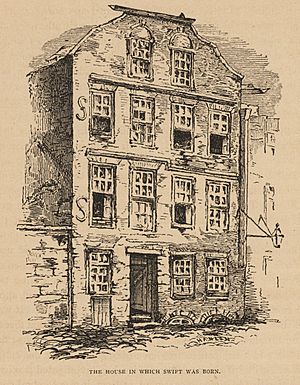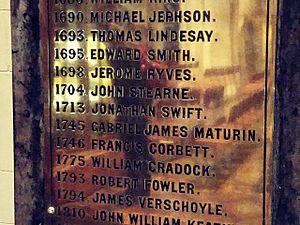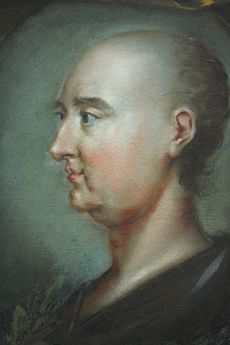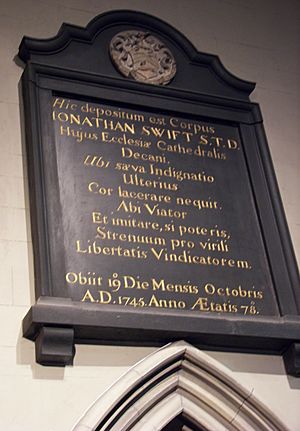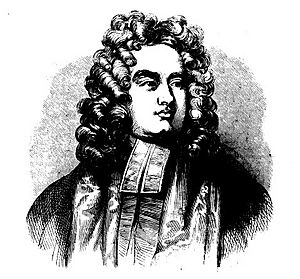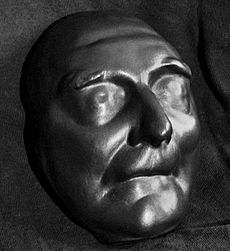Jonathan Swift facts for kids
Quick facts for kids
The Very Reverend
Jonathan Swift
|
|
|---|---|

Portrait by Charles Jervas, 1710
|
|
| Born | 30 November 1667 Dublin, Ireland |
| Died | 19 October 1745 (aged 77) Dublin, Ireland |
| Resting place | St Patrick's Cathedral, Dublin |
| Pen name |
|
| Occupation |
|
| Language | Modern English |
| Education | B.A. |
| Alma mater | Trinity College Dublin |
| Period | 18th century |
| Genres | |
| Subjects |
|
| Literary movement | |
| Years active | from 1696 |
| Notable works |
|
| Partner | Esther Johnson (?) |
| Signature | |
Jonathan Swift (born November 30, 1667 – died October 19, 1745) was a famous writer from Ireland. He is best known for his book Gulliver's Travels. Swift was also a poet, essayist, and a political writer who used humor and sharp criticism to make his points. This style is called satire.
He was an Anglican cleric, which means he was a priest in the Church of Ireland. He eventually became the Dean of St Patrick's Cathedral, Dublin. Because of this, people often called him "Dean Swift." He published many of his works using fake names, like Lemuel Gulliver, or without any name at all.
Contents
Swift's Early Life and Education
Jonathan Swift was born in Dublin, Ireland, on November 30, 1667. His father, also named Jonathan Swift, died about seven months before he was born. His mother, Abigail Erick, later returned to England.
Young Jonathan was left in the care of his uncle, Godwin Swift. When he was one year old, his nurse took him to her hometown in England. There, he learned to read the Bible. He returned to his mother in Ireland when he was three.
Swift's family had some interesting connections to other writers. His grandmother was related to the famous poet John Dryden. His great-great-grandmother's brother wrote a book called The Man in the Moone, which later influenced Swift's Gulliver's Travels.
His uncle Godwin sent him to Kilkenny College when he was six. This was a well-known school. Swift graduated from Kilkenny College in 1682, when he was 15 years old.
After Kilkenny College, Swift went to Trinity College Dublin in 1682. His cousin helped pay for his studies. The college focused on old subjects like logic and philosophy. Students learned to debate and argue different sides of a topic. Swift was a good student and earned his first degree in 1686.
Swift's Adult Life and Career
Swift was studying for a higher degree when political problems in Ireland made him move to England in 1688. His mother helped him get a job as a secretary for Sir William Temple, a retired English diplomat.
Swift lived at Temple's estate, Moor Park. He became very trusted by Temple. He even met King William III through Temple. While at Moor Park, Swift met Esther Johnson, who was eight years old at the time. He became her tutor and gave her the nickname "Stella." They remained close friends throughout her life.
In 1690, Swift left Temple's home for a short time due to health issues. He suffered from dizziness, which doctors now believe was Ménière's disease. This illness affected him for the rest of his life. He returned to Moor Park in 1691. In 1692, he earned his master's degree from Oxford.
Swift then decided to become a priest in the Church of Ireland. In 1694, he was given a church position in Kilroot, a small, quiet community in Ireland. He found this job lonely and difficult. He returned to England and Sir William Temple's service in 1696. He helped Temple prepare his writings for publication. During this time, Swift wrote The Battle of the Books, a humorous story.
Sir William Temple died in 1699. Swift stayed in England to finish editing Temple's writings. He hoped to get a good job in England, but it didn't happen. He then took a lesser job as a chaplain to the Earl of Berkeley, who was a leader in Ireland. Swift soon got a church position in Laracor, Ireland, which was close to Dublin. He spent much of his time in Dublin and often traveled to London. In 1701, he published a political pamphlet without his name on it.
Jonathan Swift as a Writer
After 1700, Swift lived in Trim, Ireland. He wrote many of his famous works during this period. In 1702, he earned his Doctor of Divinity degree. In 1704, he published A Tale of a Tub and The Battle of the Books. These works helped him become known as a talented writer.
He became good friends with other famous writers like Alexander Pope, John Gay, and John Arbuthnot. They formed a group called the Scriblerus Club.
Swift's Political Views
Swift became very involved in politics. He supported the Glorious Revolution and was initially part of the Whig political group. As a member of the Anglican Church, he worried about the return of a Catholic king.
From 1707 to 1709, Swift tried to convince the Whig government to give money to the Irish clergy, similar to what English clergy received. When the Tory party came to power in 1710, they were more open to his ideas. Swift then began to support the Tories and edited their newspaper, The Examiner.
In 1711, Swift wrote a political pamphlet called The Conduct of the Allies. It criticized the Whig government for not ending the war with France. The new Tory government secretly negotiated peace, leading to the Treaty of Utrecht in 1713, which ended the war.
Swift was close to the leaders of the Tory government. He wrote about his experiences in letters to Esther Johnson, which were later published as A Journal to Stella. When Queen Anne died in 1714, the Whigs returned to power. The Tory leaders faced serious accusations for their secret peace talks.
Swift saw himself as a "Whig in politics" because he loved liberty, but a "High-Churchman" in religion. He believed people should keep their religious opinions private to avoid conflict. It's important to remember that "Whig" and "Tory" in Swift's time were different from modern political parties.
During these years in London, Swift also became close to Esther Vanhomrigh. He called her "Vanessa" in his poem Cadenus and Vanessa. She seemed to be in love with him. Esther followed Swift to Ireland in 1714. Their friendship continued for some years. Esther Vanhomrigh died in 1723.
Swift's Later Years and Legacy
Swift had hoped for a church job in England as a reward for his work. However, Queen Anne disliked him, partly because she thought his book A Tale of a Tub was disrespectful. The best job his friends could get him was the Deanery of St Patrick's Cathedral in Dublin. This was a disappointment for Swift, and he felt like he was sent away to Ireland.
Once in Ireland, Swift used his writing skills to support Irish causes. He wrote important works like Proposal for Universal Use of Irish Manufacture (1720), Drapier's Letters (1724), and A Modest Proposal (1729). These writings made him a hero to many Irish people. The government tried to stop him, but a jury refused to say his Drapier's Letters were rebellious.
During these years, he also wrote his most famous book, Gulliver's Travels. It was published in 1726. The book uses humor and satire to comment on society and politics. Swift visited London in 1726 and stayed with his friends Alexander Pope and John Arbuthnot. They helped him publish Gulliver's Travels without his name on it. The book was an instant success.
Swift returned to England one more time in 1727. He rushed back to Ireland when he heard that Esther Johnson ("Stella") was dying. She passed away on January 28, 1728. Swift was too ill to attend her funeral. Years later, a lock of hair, believed to be Stella's, was found in his desk with the words, "Only a woman's hair."
Swift's Final Days
As Swift grew older, many of his friends passed away. In 1731, he wrote a poem called Verses on the Death of Dr. Swift, which was like his own obituary. In 1738, he began to show signs of illness. In 1742, he might have had a stroke, which made him unable to speak. He had always feared losing his mental abilities.
His friends had him declared unable to manage his own affairs to protect him. Jonathan Swift died on October 19, 1745, at nearly 78 years old. He was buried in St Patrick's Cathedral, next to Esther Johnson, as he wished.
Swift left most of his money to start a hospital for people with mental illness. This hospital, now called St Patrick's University Hospital, opened in 1757 and still exists today.
Swift's Important Writings
Jonathan Swift was a very productive writer. His collected prose works fill many books, and his poems are also very extensive.
Major Prose Works
Swift's first major prose work was A Tale of a Tub. It showed many of the ideas and writing styles he would use later.
His most famous work, Gulliver's Travels, was published in 1726. It tells the story of Lemuel Gulliver, a ship's surgeon who travels to strange lands. The book is a clever satire that makes fun of society and human flaws.
In 1729, Swift published A Modest Proposal. This is a shocking satire where the narrator suggests that poor Irish people should sell their children as food to the rich. Swift used this extreme idea to highlight the terrible poverty in Ireland and criticize the government's lack of action.
Notable Poems
Swift wrote many poems throughout his life. Some of his well-known poems include:
- "Ode to the Athenian Society" (1691)
- "Baucis and Philemon" (1706–09)
- "A Description of the Morning" (1709)
- "A Description of a City Shower" (1710)
- "Cadenus and Vanessa" (1713)
- "Stella's birthday poems" (a series of poems for Esther Johnson)
- "A Satirical Elegy on the Death of a Late Famous General" (1722)
- "Advice to the Grub Street Verse-writers" (1726)
- "The Furniture of a Woman's Mind" (1727)
- "Verses on the Death of Dr. Swift, D.S.P.D." (1731–32)
- "The Lady's Dressing Room" (1732)
- "On Poetry: A Rhapsody" (1733)
Swift's Lasting Impact
Jonathan Swift's writings have had a huge impact on literature and thought. Many famous writers and thinkers have admired his work.
For example, George Orwell, a famous writer, said he admired Swift even though he disagreed with many of Swift's ideas. Gulliver's Travels is one of the most widely read Irish books in libraries around the world.
Places Named After Swift
A crater on Deimos, one of Mars's moons, is named Swift crater. This is because Jonathan Swift had actually predicted the existence of Mars's moons in Gulliver's Travels.
In Trim, County Meath, Ireland, where Swift lived for a time, there are several things named after him. Swift's Street is named in his honor. Trim also holds a festival called the Trim Swift Festival to celebrate his legacy.
See also
 In Spanish: Jonathan Swift para niños
In Spanish: Jonathan Swift para niños


